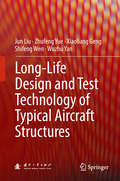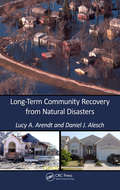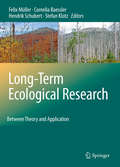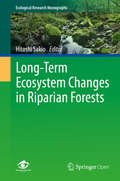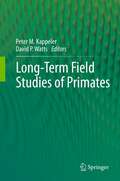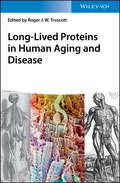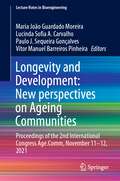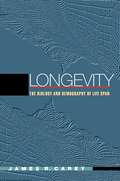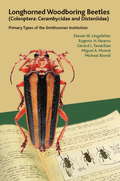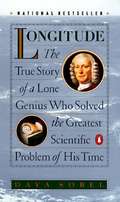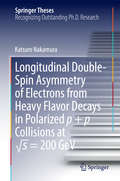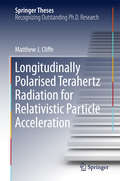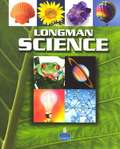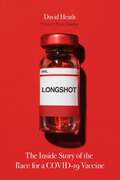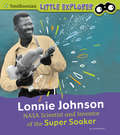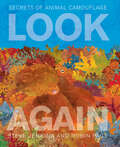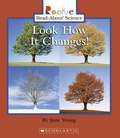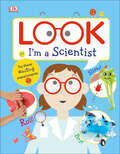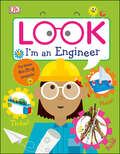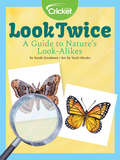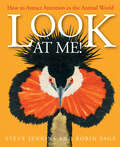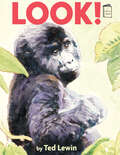- Table View
- List View
Long-Life Design and Test Technology of Typical Aircraft Structures
by Jun Liu Zhufeng Yue Xiaoliang Geng Shifeng Wen Wuzhu YanThis book addresses anti-fatigue manufacturing, analysis and test verification technologies for typical aircraft structures, including fastening holes, shot peening plates, different types of joints and wing boxes. Offering concrete solutions to practical problems in aircraft engineering, it will benefit researchers and engineers in the fields of Aerospace Technology and Astronautics.
Long-Term Community Recovery from Natural Disasters
by Lucy A. Arendt Daniel J AleschToday, governmental efforts at long-term community recovery from a natural disaster consist primarily of rebuilding the physical artifact of the community. This entails reestablishing vital community services and infrastructure and creating housing to replace that which has been lost. While restoring the built environment of a disaster area is esse
Long-Term Ecological Research
by Felix Müller Cornelia Baessler Hendrik Schubert Stefan KlotzEcosystems change on a multitude of spatial and temporal scales. While analyses of ecosystem dynamics in short timespans have received much attention, the impacts of changes in the long term have, to a great extent, been neglected, provoking a lack of information and methodological know-how in this area. This book fills this gap by focusing on studies dealing with the investigation of complex, long-term ecological processes with regard to global change, the development of early warning systems, and the acquisition of a scientific basis for strategic conservation management and the sustainable use of ecosystems. Within this book, theoretical ecological questions of long-term processes, as well as an international dimension of long-term monitoring, observations and research are brought together. The outcome is an overview on different aspects of long-term ecological research. Aquatic, as well as terrestrial ecosystems are represented.
Long-Term Ecosystem Changes in Riparian Forests (Ecological Research Monographs)
by Hitoshi SakioThis open access book presents and analyzes the results of more than 30 years of long-term ecological research in riparian forest ecosystems with the aim of casting light on changes in the dynamics of riparian forests over time. The research, focusing on the Ooyamazawa riparian forest, one of the remaining old-growth forests in Japan, has yielded a number of interesting outcomes. First, it shows that large-scale disturbances afford various trees opportunities for regeneration and are thus the driving force for the coexistence of canopy trees in riparian forests. Second, it identifies changes in reproductive patterns, highlighting that seed production has in fact quantitatively increased over the past two decades. Third, it describes the decline in forest floor vegetation caused by deer grazing and reveals how this decline has affected bird and insect populations. The book illustrates the interconnectedness of phenomena within an ecosystem and the resultant potential for cascade effects and also stresses the need for long-term ecological studies of climate change impacts on forests. It will be of interest to both professionals and academics in the field of forest science.
Long-Term Field Studies of Primates
by Peter M. Kappeler David P. WattsSome primate field studies have been on-going for decades, covering significant portions of individual life cycles or even multiple generations. In this volume, leading field workers report on the history and infrastructure of their projects in Madagascar, Africa, Asia and South America. More importantly, they provide summaries of their long-term research efforts on primate behaviour, ecology and life history, highlighting insights that were only possible because of the long-term nature of the study. The chapters of this volume collectively outline the many scientific reasons for studying primate behaviour, ecology and demography over multiple generations. This kind of research is typically necessitated by the relatively slow life histories of primates. Moreover, a complete understanding of social organization and behaviour, factors often influenced by rare but important events, requires long-term data collection. Finally, long-term field projects are also becoming increasingly important foci of local conservation activities.
Long-Term Health State Estimation of Energy Storage Lithium-Ion Battery Packs
by Qi Huang Shunli Wang Carlos Fernandez Zonghai Chen Ran Xiong Daniel-I. StroeThis book investigates in detail long-term health state estimation technology of energy storage systems, assessing its potential use to replace common filtering methods that constructs by equivalent circuit model with a data-driven method combined with electrochemical modeling, which can reflect the battery internal characteristics, the battery degradation modes, and the battery pack health state. Studies on long-term health state estimation have attracted engineers and scientists from various disciplines, such as electrical engineering, materials, automation, energy, and chemical engineering. Pursuing a holistic approach, the book establishes a fundamental framework for this topic, while emphasizing the importance of extraction for health indicators and the significant influence of electrochemical modeling and data-driven issues in the design and optimization of health state estimation in energy storage systems. The book is intended for undergraduate and graduate students who are interested in new energy measurement and control technology, researchers investigating energy storage systems, and structure/circuit design engineers working on energy storage cell and pack.
Long-lived Proteins in Human Aging and Disease
by Roger TruscottThis authoritative overview on an emerging topic in the molecular life sciences covers all aspects of the aging of (long-lived) proteins. It describes the molecular mechanisms of aging on the protein level, in particular the most common side chain modifications and includes analytical methods to study protein half-life and the accumulation of modifications. Finally, the impact of protein aging on several age-related disases in humans is dissected, and their role in limiting human lifespan is discussed.
Long-term Effects of Sewage Sludge and Farm Slurries Applications
by J.H.Williams, G.Guidi and P.L’HermiteAnaerobic digestion has no effect on the quantity of the waste treated, but it affects its quality and its usefulness as fertilizer. This conference proceedings collection of twenty papers delves into the issue.
Longevity and Development: Proceedings of the 2nd International Congress Age.Comm, November 11–12, 2021 (Lecture Notes in Bioengineering)
by Maria João Guardado Moreira Lucinda Sofia A. Carvalho Paulo J. Sequeira Gonçalves Vítor Manuel Barreiros PinheiraThis book focuses on the dynamic process of aging and on interventions to support the development of older and integrated societies, from a multidisciplinary point of view. Gathering contributions from researchers and professionals with different backgrounds, including social and health sciences, education, engineering and IT, biology, geography and environmental science, it aims at understanding the phenomenon of population aging, in order to contribute to the development of future functional communities, fostering well-being and autonomy of the elderly, their integration and participation. Based on the proceedings of the 2nd International Congress Age.Comm Longevity and Development, organised online on November 11-12, 2021, from Castelo Branco, Portugal, this book addresses a wide range of specialists dealing with the process of aging, integration and community development in the societies of the future.
Longevity: The Biology and Demography of Life Span
by James R. CareyDespite our deep interest in mortality, little is known about why some individuals live to middle age and others to extreme old age. Life span, mortality, and aging present some of the most profound mysteries in biology. In Longevity, James Carey draws on unprecedented data to develop a biological and demographic framework for identifying the key factors that govern aging, life span, and mortality in humans and other animals. Carey presents the results of a monumental, twelve-year, National Institute on Aging-funded research project on the determinants of longevity using data from the life tables of five million Mediterranean fruit flies, the most comprehensive set of life table studies ever on the mortality dynamics of a single species. He interprets the fruit fly data within the context of human aging and the aging process in general to identify the determinants of mortality. Three key themes emerge: the absence of species-specific life span limits, the context-specific nature of the mortality rate, and biodemographic linkages between longevity and reproduction. A powerful foundation for the emerging field of biodemography and a rich framework for considering the future of human life span, Longevity will be an indispensable resource for readers from a range of fields including population biology, demography, gerontology, ecology, evolutionary biology, and medical research.
Longhorned Woodboring Beetles (Coleoptera: Cerambycidae and Disteniidae)
by Miguel A. Monné Eugenio H. Nearns Michael Biondi Gérard L. Tavakilian Steven W. LingafelterIn terms of quantity and breadth, the Smithsonian Institution's collection of longhorned woodboring beetles is one of the most important in the world. The effort to establish and describe this collection began as early as 1889, when the Smithsonian hired its first coleopterist (who was also only the second salaried entomologist at the Institution). In the years that followed, the collection grew thanks to the work of not only Smithsonian and U.S. Department of Agriculture entomologists, but also passionate amateur coleopterists who collected thousands of beetle specimens as they traveled the world for their professional occupations and then donated their unique collections to the Smithsonian. By 1957, the collection included nearly 200,000 specimens from around the world. Longhorned Woodboring Beetles (Coleoptera: Cerambycidae and Disteniidae): Primary Types of the Smithsonian Institution is the first complete catalog of Coleoptera primary types housed at the Smithsonian and includes stunning full-color images of each type specimen. The product of more than a decade of curatorial research and care, it reaffirms the superior international status of this truly remarkable collection.
Longitude: The True Story of a Lone Genius Who Solved the Greatest Scientific Problem of His Time
by Dava SobelBiography of John Harrison, who solved the problem of figuring out what a ship's latitude was, by figuring out how a ship could keep precise time at sea.
Longitudinal Double-Spin Asymmetry of Electrons from Heavy Flavor Decays in Polarized p + p Collisions at sqrts = 200 GeV
by Katsuro NakamuraIn this thesis, the measurement of double-spin asymmetry for electron production from heavy flavor decays was performed in a Relativistic Heavy Ion Collider (RHIC) in the PHENIX experiment at Brookhaven National Laboratory to measure the polarized parton distribution function of gluon in the small Bjorken x region (x~0. 01). For this experiment, for the first time a Hadron Blind Detector (HBD), which is a position-sensitive gas Cherenkov counter with Gas Electron Multiplier whose surface is evaporated by CsI, was employed. This HBD contributes to reducing the background from electron pairs produced by real and virtual photon conversion. Furthermore, the author develops a new analysis method for the background reduction, and the signal-to-background ratio is improved by a factor of roughly 2. 0. Using the combination of the HBD and a new analysis method, the double-spin asymmetry of the electron production with transverse momentum ranging 0. 5 x region, a worldwide first.
Longitudinally Polarised Terahertz Radiation for Relativistic Particle Acceleration
by Matthew J. CliffeThis book elaborates on the acceleration of charged particles with ultrafast terahertz electromagnetic radiation. It paves the way for new, and improves many aspects of current, accelerator applications. These include providing shorter electron bunches for ultrafast time-resolved pump-probe spectroscopy, enabling complex longitudinal profiles to be imparted onto charged particle bunches and significantly improving the ability to synchronise an accelerator to an external laser. The author has developed new sources of terahertz radiation with attractive properties for accelerator-based applications. These include a radially biased large-area photoconductive antenna (PCA) that provided the largest longitudinally polarised terahertz electric field component ever measured from a PCA. This radially biased PCA was used in conjunction with an energy recovery linear accelerator for electron acceleration experiments at the Daresbury Laboratory. To achieve even higher longitudinally polarised terahertz electric field strengths, and to be able to temporally tune the terahertz radiation, the author investigated generation within non-linear optical crystals. He developed a novel generation scheme employing a matched pair of polarity inverted magnesium-oxide doped stoichiometric lithium niobate crystals, which made it possible to generate longitudinally polarised single-cycle terahertz radiation with an electric field amplitude an order of magnitude larger than existing sources.
Longman Science
by Pearson EducationLongman Science prepares students in grades 6-12 for success in a standards-based science program with a broad overview of life, earth, and physical science. All activities are specifically geared to students in the early stages of English language acquisition, and help build content knowledge, skills, and learning strategies. Special offer: Take advantage of our special offer: get the Longman Science Student Book and Workbook for only$44. 95. That's 25% off the regular price of these two books combined. Click here for details. Features For beginning to high beginning English language learners. "Getting Started" unit introduces concepts of science, safety, and the scientific method. Reading strategies are explicitly taught and modeled throughout the readings. Science skills, such as using and interpreting visuals, charts, and graphs are taught and recycled throughout each lesson. Unit Review provides additional practice, extension projects, further reading, and a Unit Experiment. Vocabulary building activities and glossaries help students access and build mastery of the content.
Longshot: The Inside Story of the Race for a COVID-19 Vaccine
by David HeathThis is the incredible story of the scientists who created a coronavirus vaccine in record time. In Longshot, investigative journalist David Heath takes readers inside the small group of scientists whose groundbreaking work was once largely dismissed but whose feat will now eclipse the importance of Jonas Salk&’s polio vaccine in medical history. With never-before-reported details, Heath reveals how these scientists overcame countless obstacles to give the world an unprecedented head start when we needed a COVID-19 vaccine. The story really begins in the 1990s, with a series of discoveries that were timed perfectly to prepare us for the worst pandemic since 1918. Readers will meet Katalin Karikó, who made it possible to use messenger RNA in vaccines but struggled for years just to hang on to her job. There&’s also Derrick Rossi, who leveraged Karikó&’s work to found Moderna but was eventually expelled from his company. And then there&’s Barney Graham at the National Institutes of Health, who had a career-long obsession with solving the riddle of why two toddlers died in a vaccine trial in 1966, a tragedy that ultimately led to a critical breakthrough in vaccine science. With both foresight and luck, Graham and these other crucial scientists set the course for a coronavirus vaccine years before COVID-19 emerged in Wuhan, China. The author draws on hundreds of hours of interviews with key players to tell the definitive story about how the race to create the vaccine sparked a revolution in medical science.
Lonnie Johnson: NASA Scientist and Inventor of the Super Soaker (Little Inventor)
by Lucia RaatmaWhy is Lonnie Johnson important? He invented the Super Soaker! Readers follow his journey from a NASA engineer working on missions to Jupiter and Saturn to becoming the inventor of one of the most popular toys in the United States. This story of hard work is filled with engaging text and colorful images, all reviewed by Smithsonian experts.
Look Again
by Charlotte Montgomery Deborah Drew-Brook Allan CormackThree children explore outdoors with a magnifying glass, binoculars, and a telescope.
Look Again: Secrets of Animal Camouflage
by Steve Jenkins Robin PageThe award-winning team of Steve Jenkins and Robin Page introduce young readers to some of the stealthiest, most astonishingly camouflaged animals in the natural world and ask them to seek out these sneaky animals hiding in plain sight! Ideal for readers of the Over and Under books.Why do some animals blend in to their surroundings? Why do certain creatures have fur, feathers, and features designed to look like the plants and rocks they live near? In Look Again!, the most well-disguised animals on the planet are gathered together to showcase the range of ways animals try to avoid each other's attention, and why. This eye-catching book invites readers to seek out the astonishingly camouflaged animals hiding in plain sight—then reveals them on the next page! From lying in wait to avoiding predators, protecting themselves or sneaking up on a foe, each animal in Look Again! has a remarkable skill for evading detection.
Look How It Changes!
by June Young Andrew Fraknoi Cecilia Minden-CuppThis Rookie Read-About Science book introduces young readers to chemical changes. Colorful photos and simple text encourage children to read on their own as they learn that chemical changes take place when they bake a cake or toast a marshmallow or when leaves change color in the fall.
Look I'm a Scientist (Look! I'm Learning)
by DKAn activity ebook that will help little ones discover everyday science as they play their way through 14 exciting home science experiments!Full of hands-on activities that will tap straight into your child's natural scientific curiosity. The experiments are easy to follow and use items that most people already have tucked away at home. Look I'm A Scientist is the most incredible introduction to science for kids. From an iceberg animal rescue to stretchy slime and a science wizard potion. Kids can pour it, mix it, feel it, and more, as each sensory-friendly activity becomes an ever-so-exciting science experiment.The 14 activities in this educational ebook are easy to prepare, set up, and create. A step-by-step visual guide and a charming design make it the perfect STEM activity ebook for parents and their little ones to explore together. Each activity is designed to let your child play and learn with all their senses. Together you can grow their love of science and their understanding of the world. Little scientists will discover fun facts like why water goes stiff in the freezer, what makes slime super stretchy, how to make the best soap bubbles, and lots more. With Look I'm A Scientist children can touch, smell, see, hear, and taste their way to scientific amazement.And remember, making a mess is part of the fun and learning!Find Out Why, What, And How!You were born with everything you need to be an extraordinary scientist - a fantastic brain and super senses. Get ready to touch, smell, see, hear, and taste your way to scientific discovery. Being a little scientist has never been so much fun!Full of amazing science experiments for kids like: - Homemade playdough- Ooey gooey slime- A bubble volcano- And much, much more!DK's Look! I'm Learning series of exciting and educational STEM ebooks, focus on the sensory experience of practical learning and play, and find the science in everyday activities. Hands-on learning experiences tap straight into kids' insatiable curiosity and sense of wonder. These ebooks for children are perfect for ages 3–6, formatted with a padded cover and toddler-tough pages. The series encourages children to develop independence and improves their critical thinking, investigation skills, and motor skills. Try the other titles in the series next, including Look I'm A Cook, Look I'm A Mathematician, and Look I'm An Engineer.
Look I'm an Engineer (Look! I'm Learning)
by DKThis playful preschool activity ebook for kids will unleash your child's curiosity and creativity as they play their way through 15 super fun STEM projects.Every project features bright photography and charming illustrations, which support the easy-to-follow instructions. Perfect for ages 3-6, this children's book will excite little ones by revealing the everyday ways they can be an engineer. Children are born with everything they need to be great engineers - inquisitive minds, unlimited imagination, and super senses. With this educational ebook in hand, little readers are encouraged to use their senses to investigate and discover the world of science and math while having fun.This kids book is ridiculously cool and filled with fun experiments you and your kids can do together. They'll learn how to make the strongest paper bridges, how to power a tugboat with an elastic band, which materials make the best parachutes, and much more. These ingenious hands-on activities align with subjects taught at school, including science, math, and technology.Children have the opportunity to do what they do best with this awesome kids' activity ebook - imagine, create, learn, problem-solve, and above all, play their way to engineering discovery.Get Your Engineering Hat Ready!You were born with everything you need to be an engineer - a brilliant brain and spectacular senses! Get ready to touch, smell, see, hear, and taste your way to engineering excellence. Find out how to make a floating rescue raft, what makes a bridge super strong, why paper planes glide and much, much more!Full of amazing engineering creations for kids to make like: - A magical woodland den- A sweet, sweet pyramid- The coolest paper bridge - A totally artistic painting pendulum (we're learning gravity here)- And much more!Prepare to have all the FUN!DK's Look! I'm Learning series of exciting and educational STEM ebooks focus on the sensory experience of practical learning and play and finds the science in everyday activities. Hands-on learning experiences tap straight into kids' insatiable curiosity and sense of wonder. These ebooks for children are perfect for ages 3–6 as they are formatted with a padded cover and toddler-tough pages. The series encourages children to develop independence and improves their critical thinking, investigation skills, and motor skills. Try the other titles in the series next, including Look I'm A Scientist, Look I'm A Mathematician, and Look I'm A Cook.
Look Twice: A Guide to Nature's Look-Alikes
by Sarah GoodmanWhen you look, always look twice, and maybe even listen. You're bound to see a thing or three that everyone else is missing.
Look at Me!: How to Attract Attention in the Animal World
by Robin PageThe latest offering from the award-winning team of Robin Page and Steve Jenkins focuses on the most unique and exciting animal displays in the natural world, used by creatures to stand out. This eye-catching, high-interest material is ideal for nature lovers, Jenkins fans, and even the most reluctant readers. Have you ever noticed that certain creatures have fur, feathers, and features designed to catch your eye? Chock-full of the fascinating facts and stunning art readers have come to expect from Jenkins and Page titles, Look at Me! is a pleasure to look at and an engrossing read. Showcasing the most attention-grabbing animals on the planet gathered together, Look at Me! helps readers understand the range of ways animals try to get one another's attention and why. From luring in prey to warning off predators, protecting themselves to attracting a mate, each animal has a remarkable display. These are animals you won't want to miss.
Look! (I Like to Read)
by Ted LewinLook! An elephant eats. Look! Giraffes drink. Look! A warthog digs. A gorilla hides, wild dogs listen, zebras run, monkeys sit, hippos splash, and a rhino naps. Each line of text is illustrated by a two-page spread with a beautiful painting of an animal Ted Lewin has seen on his journeys to Africa. At the end of the story, a boy reads, plays, and dreams, surrounded by toy animals that represent each of the real ones. This book encourages children to observe, enjoy, and appreciate the natural world. Guided Reading Level D.
